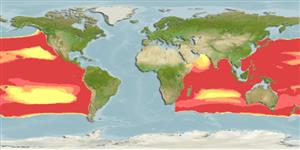>
Anguilliformes (Eels and morays) >
Serrivomeridae (Sawtooth eels)
Etymology: Serrivomer: Latin, serran, serranus, saw + Latin, vomer = ploughshare; in fishes = bone forming the front part of the roof of the mouth (1823) (Ref. 45335); jesperseni: Named after P. Jespersen, monographer of the anguillid letocephalids..
Environment: milieu / climate zone / depth range / distribution range
Ecología
marino batipelágico; rango de profundidad ? - 825 m (Ref. 6885). Deep-water
Western Pacific: Papua New Guinea. Eastern Pacific: British Columbia, Canada (Ref. 6885), Gulf of Panama (Ref. 6993) and Chile (Ref. 9068).
Tamaño / Peso / Age
Maturity: Lm ? range ? - ? cm
Max length : 67.0 cm TL macho / no sexado; (Ref. 96339)
Short description
Morfología | Morfometría
Espinas dorsales (total): 0; Radios blandos dorsales (total): 141-170; Espinas anales 0; Radios blandos anales: 127 - 161; Vértebra: 150. Dorsal and anal fins confluent with caudal fin; caudal minute and narrow; pectorals small (Ref. 6885). Dark in color; mouth, lining of gill cover, and peritoneum black (Ref. 6885).
Life cycle and mating behavior
Madurez | Reproducción | Puesta | Huevos | Fecundidad | Larva
Hart, J.L., 1973. Pacific fishes of Canada. Bull. Fish. Res. Board Can. 180:740 p. (Ref. 6885)
IUCN Red List Status (Ref. 130435)
Threat to humans
Harmless
Human uses
Más información
Nombres comunesSinónimosMetabolismoDespredadoresEcotoxicologíaReproducciónMadurezPuestaAgregación para la puestaFecundidadHuevosEgg development
Age/SizeCrecimientoLength-weightLength-lengthLength-frequenciesMorfometríaMorfologíaLarvaDinámica larvariaReclutamientoAbundanciaBRUVS
ReferenciasAcuiculturaPerfil de acuiculturaRazasGenéticaElectrophoresesheritabilidadEnfermedadesProcesamientoNutrientsMass conversion
ColaboradoresImágenesStamps, Coins Misc.SonidosCiguateraVelocidadTipo de nataciónSuperficie branquialOtolitosCerebrosVisión
Herramientas
Special reports
Download XML
Fuentes de Internet
Estimates based on models
Preferred temperature (Ref.
123201): 7 - 14.8, mean 10.5 °C (based on 453 cells).
Phylogenetic diversity index (Ref.
82804): PD
50 = 0.5059 [Uniqueness, from 0.5 = low to 2.0 = high].
Bayesian length-weight: a=0.00102 (0.00046 - 0.00225), b=3.06 (2.88 - 3.24), in cm total length, based on all LWR estimates for this body shape (Ref.
93245).
Nivel trófico (Ref.
69278): 3.8 ±0.5 se; based on size and trophs of closest relatives
Resiliencia (Ref.
120179): Bajo, población duplicada en un tiempo mínimo de 4.5-14 años (Assuming tmax>10).
Fishing Vulnerability (Ref.
59153): Moderate to high vulnerability (47 of 100).
